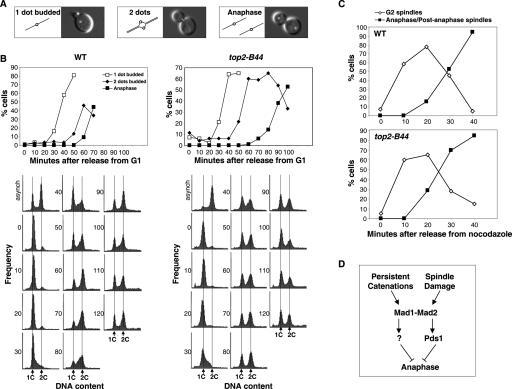Figure 6.
Chromosomes biorient properly in top2-B44 cells. (A) Schematic representation (cartoons) and photomicrographs describing a chromosome biorientation assay in budding yeast. (Left) A locus at CEN4 is tagged with a fluorescent signal (see Materials and Methods) yielding a single fluorescent dot in small budded cells. (Middle) Two closely apposed fluorescent spots are seen once the CEN4 locus has been replicated and has undergone the typical precocious separation (Goshima and Yanagida 2000) seen when the chromosome becomes bioriented, and is under spindle tension. (Right) During anaphase, the spots are segregated to the mother and daughter cells. (B) Cell cycle analysis of wild-type and top2-B44 mutants after release from G1 synchrony. (Bottom) Cell morphologies were scored as depicted in A, and samples were processed for FACScan analysis of DNA content (time points are shown at the side of each histogram plot and the vertical lines indicate approximate position of 1C and 2C DNA contents). (C) Cell cycle analysis of wild-type versus top2-B44 mutants at 32°C. Cells were released from mating pheromone-induced G1 synchrony into medium containing nocodazole, then released from the nocodazole after 120 min. Samples were processed for cytology and spindle morphology was scored. (D) Model showing the proposed relationship between the Topo II checkpoint and the spindle assembly checkpoint in yeast. We suggest that the Topo II checkpoint is activated until decatenation reactions have been performed adequately to allow a successful mitosis. In this case, anaphase is inhibited independently of Pds1/securin.

